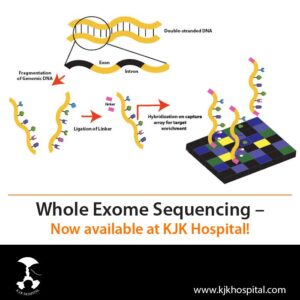
The genomes which is the sum of all the DNA in the body contains every bit of information on traits, health intricacies, genetic data and even ancestry. The technique of DNA sequencing which helps to determine the order of the DNA building blocks has found it’s use especially in testing for genetic diseases. Taking this to a whole new next generation level are two methods in particular which is the whole exome sequencing and whole genome sequencing. These methods make use of the latest technologies in healthcare to enable the rapid sequencing of large amounts of DNA.
An exome is the part of the genome that consists of exons and this make up 1 percent of a person’s genome. The exome comprises only a 2% portion of the entire genome. Whole exome sequencing involves sequencing this by allowing variations in the protein-coding region of any gene to be identified. Most known mutations that cause disease happen to occur in exons, and hence whole exome sequencing is an efficient method to identify such possible disease-causing mutations. Whole-genome sequencing has many applications in different fields, ranging from personalized medicine to general wellness. Especially in the case of fertility treatment, the information contained in the genome can be used to identify if any partners carry genetic conditions or rare diseases.
Mutations that occur in the coding regions of genes are more harmful. The method of whole-exome sequencing is powerful enough to sequence the entire coding region of a genome. This could mean that more than 85% of disease-causing variants can be sequenced or detected in this method. When compared to the earliest Sanger method of sequencing, whole exome sequencing is faster as it can sequence the entire genome of 3 billion bases within a day to a week. Not just in clinics, whole exome sequencing is quite valuable for researchers as well. Continued study of exome sequences can help determine whether new genetic variations are associated with health conditions, thereby aiding disease diagnosis in the future.
Genetic testing for diseases can help identify the person’s susceptibility to multifactorial diseases that are caused by a combination of genetic predisposition and lifestyle or environmental factors. Dominant genetic diseases can also be tested as these have a significant impact on the health of entire families and communities. Such diseases can include conditions such as Huntington’s disease, Brugada syndrome, certain vascular malformations, neurofibromatosis type 1, Marfan syndrome, familial hypercholesterolemia, and Gardner’s syndrome, amongst many others. Genome sequencing can be particularly helpful for prospective parents who are dealing with fertility issues or who have family members with genetic disorders. This is already being used in pediatrics to treat children with difficult-to-diagnose diseases.
Whole exome sequencing that uses exome enrichment can efficiently identify coding variants across a broad range of applications, including population genetics, genetic disease, and cancer studies. Some of the advantages of exome sequencing include achieving comprehensive coverage of coding regions, providing a cost-effective alternative to whole-genome sequencing, producing a smaller, more manageable data set for faster, easier data analysis when compared to the extensive whole-genome approaches. Whole exome sequencing proves to offer a much more efficient analysis of the coding regions and also a cost-effective approach when whole-genome sequencing is not practical or necessary.
For enquiries and online appointments, send a message to www.KJKHospital.com/contact





